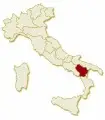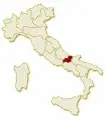All
Malvasia di Lipari 90% and other local vines 10% (1)
56% Merlot, 40% Cabernet-Sauvignon, 4% Cabernet-Franc (1)
70% Pinot Noir and 30% Chardonnay (2)
(1)
Corvina Veronese 40%, Corvinone 40% e Rondinella 20% (1)
Sangiovese 60% - Merlot, Alicante, Petit Verdot 40% (1)
(1)
90% Pinot Noir and 10% Pinot Blanc (1)
(1)
(1)
100% Bronner (1)
(1)
(1)
Cannonau, Bovale e Cagnulari (1)
62% Merlot 33% Cabernet Sauvignon 5% Cabernet Franc (1)
60% Chardonnay, 40% Pinot Nero (1)
Merlot, Syrah, Montepulciano (1)
40% Cabernet franc, 35% Cabernet Sauvignon e 25% Merlot (1)
100% Solaris (1)
Cabernet Sauvignon, Cabernet Franc, Merlot e Granache (1)
(1)
Native white grape (1)
(1)
50% Merlot - 35% Cabernet Sauvignon - 15% Syrah (1)
(1)
63% Cabernet Sauvignon 33% Merlot 3% Cabernet Franc 1% Petit Verdot (1)
(1)
50% Cannonau e 50% Cagnulari (1)
48% Cabernet Sauvignon, 43% Merlot e 9% Cabernet Franc (1)
70% Sangiovese e 30% Cabernet Sauvignon (1)
100% Cabernet sauvignon (16)
Cabernet Sauvignon 60%, Merlot 30%, Petit Verdot 10% (1)
(1)
Pinot Nero, Chardonnay, Meunier, Pinot Bianco, Pinot Grigio, Arbane and Petit Meslier. (1)
(3)
100% Corinto Nero (2)
Merlot 47,9% Cabernet sauvignon 45,8% Cabernet franc 6,3% (1)
50% Pinot Noir e 50% Chardonnay (1)
(1)
(1)
(1)
74 % Merlot 17 % Cabernet Sauvignon 9 % Cabernet Franc (1)
(1)
95% Malvasia e 5% Corinto Nero. (1)
42% Cabernet Franc, 31% Cabernet Sauvignon e 27% Merlot (1)
(1)
(1)
(1)
60% Cabernet Sauvignon, 30% Merlot and 10% Cabernet Franc (1)
Cabernet Sauvignon, Cabernet Franc, Carmenere, Merlot (1)
Merlot, Cabernet Sauvignon (1)
(1)
65% Cabernet Sauvignon 34% Merlot 1% Petit Verdot (1)
100% Merlot Khorus (1)
(1)
(1)
100% Cagnulari (2)
(1)
75% Syrah - 25% Sangiovese (1)
Merlot 54% Cabernet sauvignon 42% Petit verdot 4% (1)
57,3% Pinot Noir and 42,7% Chardonnay (1)
35% Corvina, 45% Corvinone e 20% Rondinella (1)
100% Sangiovese (90)
100% Aglianico (32)
100% Uva di Troia (2)
100% Greco (3)
100% Chardonnay (52)
100% Syrah (10)
100% Nero d'Avola (10)
100% Grillo (10)
100% Nebbiolo (134)
100% Dolcetto (17)
100% Montepulciano (20)
100% Trebbiano (13)
100% Vermentino (25)
100% Sauvignon (20)
100% Pinot nero (47)
100% Merlot (25)
100% Glera (19)
100% Friulano (5)
100% Pinot grigio (17)
100% Ribolla gialla (11)
100% Malvasia (12)
100% Pinot bianco (5)
100% Passerina (4)
100% Vernaccia Nera (5)
100% Verdicchio (9)
100% Lacrima di Morro d’Alba (1)
100% Marzemino (2)
100% Cabernet Franc (8)
100% Teroldego (4)
100% Schiava (3)
100% Müller Thurgau (4)
100% Moscato Giallo (11)
100% Gewürztraminer (5)
100% Lagrein (5)
100% Barbera (62)
100% Cortese (7)
100% Arneis (13)
100% Erbaluce di Caluso (4)
100% Favorita (4)
100% Brachetto (1)
100% Oseleta (1)
100% Lambrusco Maestri (27)
100% Malvasia di Candia Aromatica (7)
100% Greco di Tufo (5)
100% Fiano di Avellino (3)
100% Falanghina (14)
100% Fiano (8)
100 % Piedirossa (1)
100% Nero di Troia (8)
100 % Primitivo (22)
100% Moscato Bianco (13)
100% Grechetto Gentile (1)
100% Lambrusco Grasparossa di Castelvetro (10)
100% Gavi (7)
100% Malbech (2)
100% Traminer (4)
100% Refosco dal peduncolo rosso (6)
100% Pecorino (6)
100% Pignoletto (8)
100% Corvina (5)
100% Raboso (4)
100% Negroamaro (5)
100% Perricone (3)
100% Nerello Mascalese (16)
100% Catarratto (6)
100% Bombino bianco (3)
100% Zibibbo (3)
100% Riesling Renano (2)
100% Schioppettino (7)
100% Bovale Sardo (3)
100% Cannonau (9)
100% Insolia (5)
100% Viognier (6)
100% Ruchè (4)
100% Grignolino d’Asti (3)
100% Cabernet (1)
100% Croatina (1)
100% Riesling Italico (1)
100% Pinot Meunier (2)
100% Bonarda (1)
100% Lambrusco Marani (2)
100% Picolit (2)
100% Ciliegiolo (3)
100 Manzoni Bianco (1)
100 Caricante (6)
100 Cococciola (1)
100% Garganega (6)
100% Frappato (3)
100% Recantina (1)
100% Albarossa (1)
100% Pignolo (3)
100% Turbiana (1)
100% Sagrantino (5)
100% Grignolino (4)
100% Verdeca (1)
100% Vernaccia di San Gimignano (4)
100% Verduzzo (4)
100% Malvasia Nera (1)
100% Cesanese (1)
100% Spergola (1)
100% Alicante (1)
100% Coda di Volpe (2)
100% Ansonica (1)
100% Grenache (1)
100% Torbato (4)
100% Carignano (1)
100% Albarola (1)
100% Freisa (3)
100% Timorasso (6)
100% Soave (1)
100% Petite Arvine (2)
100% Gamay (1)
100% Prëmetta (1)
100% Cornalin (1)
100% Fumin (2)
100% Vespolina (1)
chardonnay 70%, pinot nero 30% (2)
corvina veronese 60%, rondinella 30%, molinara 10% (1)
chardonnay 50%, pinot nero 50% (1)
Corvina 40%, Corvinone 30%, Rondinella 15%, Oseleta 10%, Croatina 5% (2)
Vermentino e Trebbiano (1)
Trebbiano Toscano e Malvasia Bianca Lunga (1)
Pinot Meunier, Pinot Noir e Chardonnay (1)
65% Cabernet Sauvignon, 25% Merlot, 10% Cabernet Franc (1)
Chardonnay e Fiano (1)
100% Carmenère (1)
90% Vernaccia 10% Chardonnay (1)
90% Sangiovese 10% Ciliegiolo (1)
90% Sangiovese 10% Merlot, Colorino (1)
90% Sangiovese 10% Canaiolo, Colorino (2)
80% Sangiovese 20% Merlot, Canaiolo, Malvasia Nera (1)
90% Cabernet Sauvignon 10% Petit Verdot (1)
70% Barbera e 30% Bonarda (1)
Fiano e Chardonnay (1)
50% Nero d’Avola 50% Frappato (1)
Sangiovese; Canaiolo ed altre varietà a bacca rossa. (1)
Autochthonous white grapes (1)
Nero d’Avola e Perricone (1)
Corvina 65% Rondinella 30% altre autoctone 5% (2)
Merlot e Sangiovese (3)
Malvasia e Trebbiano (2)
Sangiovese e Aglianico (1)
Chardonnay, Müller T., Sauvignon Blanc, Nosiola (1)
Teroldego, Cabernet S., Merlot (1)
Merlot, Cabernet S., Sangiovese (1)
Chardonnay e Pinot Nero (6)
Groppello, Marzemino, Sangiovese e Barbera (1)
Turbiana, Chardonnay e Sauvignon Blanc (1)
Vermentino, Grechetto e Trebbiano (2)
Sangiovese e Colorino (2)
Pinot Grigio e Sangiovese (1)
Sangiovese, Merlot e Sagrantino (1)
60% barbera 40% Croatina (2)
Trebbiano, Grechetto e Chardonnay. (1)
cabernet sauvignon 50%, merlot 25%, petit verdot 25% (1)
Nerello Mascalese e Nerello Cappuccio (2)
Corvina, Corvinone, Rondinella, Croatina (1)
50% Cabernet Sauvignon, 30% Merlot, 10% Cabernet Franc, 10% Sangiovese. (1)
Cabernet Sauvignon, Cabernet Franc, Merlot e Syrah (1)
Bacca bianca (1)
Cabernet Sauvignon e Sangiovese (1)
Vermentino e Chardonnay (1)
Sangiovese e Cabernet (1)
Chardonnay, Grechetto e Sauvignon Blanc. (1)
Sangiovese, Canaiolo e Traminer (1)
Moscato rosa (1)
Chardonnay e Sauvignon. (1)
Cabernet Sauvignon e Cabernet Franc (1)
Sangiovese e Cabernet Sauvignon (3)
Roscetto, Trebbiano, Malvasia (1)
Cabernet Sauvignon 50%, Merlot 40%. Barbera 5%. Nebbiolo 5% (1)
Bombino bianco e Pinot nero (3)
100% Roscetto (2)
Corvina Veronese 40%, Corvinone 30%, Rondinella 25%, Sangiovese 5% (1)
40% Syrah, 30% Merlot, 30% Cabernet Sauvignon (1)
85% Sangiovese, 15% Cabernet Sauvignon (1)
60% Greco Mascolino - 40% Malvasia (1)
Aglianico - Uva di Troia - Primitivo - Cabernet - Merlot (1)
30% Garganega 25% Cortese 20% Trebbiano 10%Malvasia 5% Tocai (1)
Corvina 60%, Corvinon 20% , Rondinella 10%, Molinara 7%, Oseleta 3% (1)
corvina 60%, corvinon 20%, rondinella 10%, croatina 7%, oseleta 3% (1)
Corvina 60%, Corvinon 20%, Rondinella 10%, Molinara 10% (1)
Corvina 60%, Corvinon 25%, Rondinella 15% (2)
Lambrusco Salamino (1)
Lambrusco, Salamino e Marani (2)
Lambrusco, il Salamino e il Marani (1)
70% Barbera e 30% Merlot (1)
65% Bombino Bianco - 20% Pampanuto - 15% Chardonnay (1)
80% Sangiovese e 20% Cabernet Sauvignon (2)
Sangiovese 80%, Canaiolo 10%, Cabernet 10% (1)
Sangiovese, Merlot (1)
100% Pinot Noir Viognier (1)
Pinot Noir - Sauvignon Blanc (1)
Croatina e Barbera (2)
85% Cabernet Sauvignon, e 15% Cabernet Franc (2)
Montepulciano e Pinot nero (2)
Pinot Nero e Chardonnay e Recantina (1)
70% Sangiovese, 20% Cabernet Sauvignon e 10% Canaiolo (1)
100% Aleatico (2)
Syrah Merlot (1)
40% Nero di Troia - 10% Cabernet Sauvignon - 50% altri vitigni autoctoni (1)
90% Negroamaro - 10% Malvasia Nera (1)
60% barbera, 40% nebbiolo (1)
40% cabernet, 20% nebbiolo, 20% barbera, dolcetto, syrah, petit verdot (1)
Sangiovese, Cabernet Sauvignon (2)
100% Susumaniello (1)
Negroamaro e Malvasia Nera (1)
100% Bombino Nero (1)
80% Sangiovese, 15% Merlot, 5% Cabernet Sauvignon (1)
Marzemino, Sangiovese e Cabernet 10% (1)
90% Sangiovese e 10% Cabernet Sauvignon. (1)
55% Corvina, 30% Rondinella e 15% Molinara di Campiano. (1)
Sangiovese, Merlot (4)
Corvina 70% e Rondinella 30% (1)
70% Corvina e 30% Rondinella. (1)
Nero D'Avola e Merlot (1)
Trebbiano toscano 70%, Garganega 30% (1)
60% Rondinella Bianca, 15% Gold Traminer 15% Kerner, 10% Incrocio Manzoni (1)
15 vitigni, 4 bianchi e 11 rossi: Garganega, Trebbiano toscano, Sauvignon Blanc, Chardonnay, Corvina, Corvinone, Rondinella, Cabernet Sauvignon, Cabernet Franc, Merlot, Syraz, Teroldego, Croatina, Oseleta, Sangiovese, Marzemino (2)
Corvina 40%, Corvinone 30%, Rondinella 25%, Oseleta 5% (2)
Corvina 65%, Rondinella 30%, Molinara 5% (1)
corvina 60%, rondinella 20%, croatina 10%, oseleta 10% (1)
95% Sangiovese, 5% colorino. (2)
Cabernet Sauvignon 60%, Cabernet Franc 20%, Merlot 20% (1)
Turbiana e Chardonnay (1)
Negroamaro e Primitivo (2)
Bombino Bianco, Pinot nero, Montepulciano (1)
Sangiovese, Canaiolo ed altre varietà. (1)
Sauvignon e Tai (1)
Pecorino, Cacciuno e santo Marino (1)
Galoppo o Magliocco (1)
Sangiovese 80% - Merlot, Syrah, Petit Verdot 20% (1)
Pinot Nero e Chardonnay (4)
Teroldego, Cabernet S. (1)
Lambrusco Marani, Maestri, Salamino filtrato dolce di lambrusco (1)
cuveè cabernet, merlot, lagrein (1)
Garganega, Trebbiano, Incrocio Manzoni. (1)
Turbiana 90%, Rondinella 10% (1)
Corvina 60%, Rondinella 30% e Molinara 10% (1)
Sangiovese 60%, Cabernet Sauvignon 40% (1)
Sangiovese, Malvasia nera, Colorino,Merlot e Cabernet Sauvignon. (1)
(1)
Glera e Pinot Nero (1)
Sangiovese e Merlot (1)
Incrocio Bruni, Pecorino (1)
Rosciola frappato e Malvasia rossa (2)
Sangiovese 85%,Merlot 5%, CabernetSauvignon 10% (1)
Sangiovese 70%,Merlot 20%, CabernetSauvignon 5%, Syrah5% (1)
50% merlot, 20% cabernet franc e 30% cabernet sauvignon (1)
Merlot, Sangiovese (1)
MontepulcianoD'Abruzzo, Sangiovese,Primitivo di Manduria,Negramaro, MalvasiaNera (1)
Montepulciano e altre uve rosse (1)
Sangiovese 75%, Cabernet 10% (1)
Sangiovese 90%, Cabernet 10% (1)
Sangiovese 80%, Cabernet 10%, Canaiolo nero 10% (1)
(4)
Corvina Veronese 45%, Corvinone 45%, Rondinella 5%,Oseleta 5% (1)
Corvina 40%, corvinone 30%, rondinella 25%, molinara 5%. (2)
(1)
(5)
Schiava 90% Lagrein 10% (1)
Sangiovese, Cabernet Sauvignon e Syrah (3)
Cabernet Sauvignon, Cabernet Franc e Peti Verdot (1)
Sangiovese, Chianti Classico (1)
Sauvignon Blanc e Viognier (1)
Sangiovese, Canaiolo (1)
Corvina 60%, Rondinella 25% e Molinara 15% (1)
Corvina, Rondinella, Oseleta, Merlot (1)
Corvina 70%, Rondinella 25%, Corvinone 5% (1)
Corvina, Rondinella e Pelara. (1)
50% Sangiovese, 50% Cabernet Sauvignon (1)
100% Fortana (1)
Corvina 50%, rondinella 35%, molinara 5%, dindarella 5%, vecchi vitigni autoctoni 5% (1)
Sangiovese 90% - 5% Merlot – 5% Colorino (1)
Caricante e Catarratto (1)
60% Pinot Nero e 40% Chardonnay (1)
Nebbiolo, Pinot Nero, Barbera e Dolcetto (1)
Incrocio Bruni 54 (1)
(1)
Sangiovese 25%,Cabernet Sauvignon50%, Merlot 25% (1)
85% Sangiovese and 15% Petit Verdot (1)
Sangiovese and Petit Verdot (1)
60% nerello mascalese 40% nerello cappuccio (1)
Primitivo - Aglianico (1)
80% Chardonnay, 10% Pinot Nero anf 10% Pinot Bianco (1)
Fiano & Chardonnay (1)
90% Cabernet Sauvignon, 6% Merlot, 4% Carmenère (1)
Riesling Picolit e Malvasia (1)
(1)
50% Aglianico, 30% Barbera e 20% Merlot (1)
(1)
(1)
20% Pinot Meunier 20% Pinot Noir 60% Chardonnay 18% vino rosso (1)
Chardonnay, Spergola and Lambrusco (1)
Chardonnay and Spergola (1)
Lambrusco, Barbera e Bonarda (1)
Trebbiano, Malvasia, Roscetto (1)
(1)
(1)
(3)
(1)
Corvina Veronese 60%, Corvinone 20%, Rondinella 15%, Oseleta 5% (1)
(1)
chardonnay, pinot (1)
corvina gentile 30%, corvinone 35%, rondinella 25%, raboso veronese 5%, molinara 5%. (1)
(1)
75% Merlot e 25% Sangiovese (1)
20% Pinot Meunier 20% Pinot Noir 60% Chardonnay. (1)
65% Corvina, 30% Rondinella, 5% uve autoctone (1)
Ruchè e Barbera d’Asti (1)
(1)
Nero d’Avola - Syrah - Frappato (1)
Nerello Mascalese 80% - Syrah 15% - Frappato 5% (1)
(1)
Nero d’Avola 60% - Frappato 40% (1)
Carricante 95% - Minnella 5% (1)
Nerello Mascalese 90% - Nerello Cappuccio 10% (1)
Carricante 90% - Catarratto 10% (1)
Nerello Mascalese 80% - Nerello Cappuccio 20% (1)
Cabernet Sauvignon, Merlot, Cabernet Franc e Petit Verdot (1)
60% Sangiovese e 40% Merlot (1)
(1)
Cabernet Sauvignon and Cannonau (1)
80% Merlot e 20% Sangiovese (1)
Corvina 60%, rondinella 30%, molinara 10% (1)
50% Chardonnay and 50% Pinot bianco (2)
(1)
(1)
Chardonnay e Pinot Bianco (1)
(1)
(1)
Sangiovese 80%, Cabernet 10%, Canaiolo nero 5%, altri vitigni rossi 5% (1)
80% Nebbiolo, 10% Vespolina and 10% Croatina. (1)
(1)
Malvasia, Falanghina e Chardonnay (1)
90% Chardonnay 10% Glera (1)
Merlot, Malbech e Moscato (1)
Pinot bianco 30%, Chardonnay 70% (1)
(1)
Merlot, Cabernet e Lambrusco (1)
85% Sangiovese 15% Merlot (1)
50% Sangiovese 50% Merlot (1)
(1)
Trebbiano and Grechetto (1)
MontepulcianoD'Abruzzo, Sangiovese,Primitivo di Manduria,Negramaro, MalvasiaNera (1)
Vitigni a bacca biancatipici abruzzesi (1)
Sangiovese 50%,Merlot 30%, CabernetSauvignon 20% (1)
100% Pignatello (3)
100% Moscato rosa (1)
Cabernet Sauvignon 55% Merlot 45% (1)
54% Pinot Noir, 36% Pinot Meunier, 10% Chardonnay (1)
80% Chardonnay, 20% Pinot Noir (1)
76% Pinot Nero, 13% Pinot Meunier, 11% Chardonnay (1)
45% Pinot Noir, 35% Pinot Meunier, 20% Chardonnay (1)
(1)
Chardonnay, Sauvignon Blanc, Arneis (1)
Garganega 90% e Trebbiano di Soave 10% (1)
Merlot, Cabernet Sauvignon, Carmenere, Refosco e Marzemino (1)
95% Petit Rouge e 5% Fumin (1)
75% Petit Rouge e 10% Fumin, 10% Cornalin e 5% Premetta (1)
60% Sangiovese - 40% Merlot (1)
60% sangiovese - 40% syrah (1)
Lambrusco, Cabernet, Malbo Gentile (1)
(1)
(1)
Lambrusco Reggiano Ancellotta e Lambrusco Salamino (1)
Lambrusco Montericco, Ancellotta, Salamino (1)
Sangiovese 90%, Canaiolo 5%, CabernetSauvignon 5% (1)
Sangiovese (60%) e Merlot (40%) (1)
(1)
Sangiovese 70%, Canaiolo nero 20%, Cabernet 10% (1)
Merlot, Cabernet Sauvignon e Sangiovese (1)
70% Corvina, 20% Corvinone, 10% Rondinella e Molinara (4)
(1)
(1)
(1)
Cabernet sauvignon 40%, Syrah 35%, Merlot 25% (1)
(1)
(1)
90% Arneis e 10% altre uve aromatiche (1)
(1)
Cabernet Sauvignon, Merlot, Sangiovese (2)
70% Cabernet Sauvignon e 30% Cabernet Franc (1)
Corvina 65%, Rondinella 30%, altre uve autoctone 5% (1)
corvina 40%, corvinone 35%, rondinella 20%, oseleta 5% (1)
(1)
Corvina 60%, Oseleta 15%, Cabernet Franc 25% (1)
Sangiovese e Vermentino (1)
(1)
60% Fiano, 20% Moscato e 20% Falanghina (1)
70% Fiano e 30% Moscato Giallo. (1)
86% Chardonnay and 14% Pinot Nero (1)
Corvina 65%, Rondinella 30% e Molinara 5% (1)
(1)
(1)
Piedirosso 80%, Olivella 10% and Aglianico 10% (1)
(1)
Lambrusco di Sorbara e Grasparossa (1)
Glera, Falanghina (1)
Cabernet, Merlot e Piedirosso (1)
50% Vernaccia di San Gimignano, 30% Vitigni Aromatici and 20% Trebbiano Toscano (1)
Grillo, Insolia, Viognier (1)
Nero D’Avola, Syrah (1)
Ppinot bianco, Chardonnay, Sauvignon (1)
Sauvignon Blanc, Pinot Grigio, Pinot Bianco (1)
(1)
Primitivo, Negroamaro e Malvasia nera (1)
80% Pinot nero, 20% Chardonnay (1)
100% Cerasuolo (1)
Uva di Troia 55%, Montepulciano 30%, Bombino Bianco 15% (1)
(1)
(1)
(1)
Sangiovese, Ciliegiolo, Cannaiolo (1)
Massaretta, Alicante, Albarossa (1)
(1)
40% Merlot, 30% Refosco e30% Schioppettino. (1)
80% nebbiolo, 10% vespolina e 10% croatina (1)
(1)
(1)



























































